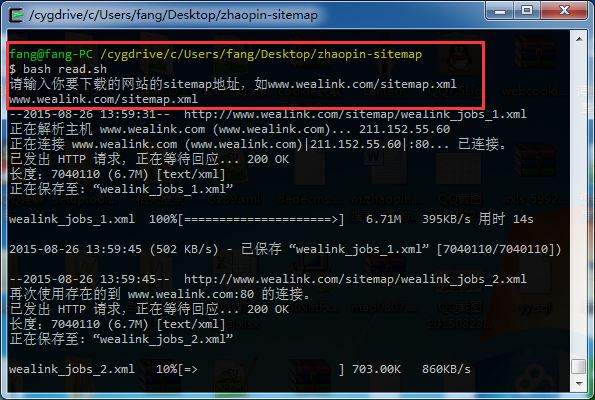- A+
一、获取用户输入
1、基本读取read命令接收标准输入的输入,或其它文件描述符的输入。得到输入后,read命令将数据输入放入一个标准变量中。
[root@rac2 ~]# cat t8.sh
#!/bin/bash
#testing the read command
echo -n "enter your name:" ---:-n用于允许用户在字符串后面立即输入数据,而不是在下一行输入。
read nameecho "hello $name ,welcome to my program."
[root@rac2 ~]# ./t8.sh
enter your name:zhouhello zhou ,welcome to my program.
read命令的-p选项,允许在read命令行中直接指定一个提示:
[root@rac2 ~]# cat t9.sh
#!/bin/bash
#testing the read -p option
read -p "please enter your age:" age ---age与前面必须有空格
echo "your age is $age"
[root@rac2 ~]# ./t9.sh
please enter your age:10
your age is 10
2、在read命令中也可以不指定变量,如果不指定变量,那么read命令会将接收到的数据防止在环境变量REPLAY中
[root@rac2 ~]# cat t10.sh
#!/bin/bash
#tesing the replay environment variable
read -p "enter a number:"factorial=1
for (( count=1; count<=$REPLY; count++ ))
do factorial=$[ $factorial * $count ]
done
echo "the factorial of $REPLY is $factorial"
[root@rac2 ~]# ./t10.sh
enter a number:5
the factorial of 5 is 120
3、计时-t选项指定read命令等待输入的秒数。当计时器计时数满时,read命令返回一个非零退出状态
[root@rac2 ~]# cat t11.sh
#!/bin/bash
#timing the data entryif read -t 5 -p "please enter your name:" namethen
echo "hello $name ,welcome to my script"else echo "sorry ,tow slow!"fi
[root@rac2 ~]# ./t11.sh
please enter your name:zhouhello zhou ,welcome to my script
[root@rac2 ~]# ./t11.sh
please enter your name:sorry ,tow slow!
4、默读有时候需要脚本用户进行输入,但不希望输入的数据显示在监视器上,(实际上是显示的只是read命令将文本颜色设置为与背景相同的了)。
[root@rac2 ~]# cat t12.sh
#!/bin/bash
#hiding input data from the monitor
read -s -p "enter your password:" passe
cho "is your password really $pass?"
[root@rac2 ~]# ./t12.sh
enter your password:is your password really 12345?
5、读取文件每调用一次read命令都会读取文件中的一行文本,当文件中没有可读的行时,read命令将以非零退出状态退出。
[root@rac2 ~]# cat t13.sh
#!/bin/bash
count=1
cat test | while read linedo echo "line $count:$line" count=$[$count + 1]
done
[root@rac2 ~]# ./t13.sh
line 1:zhouline 2:xiaoline 3:zhou
实际应用
以前在做SEO数据分析时经常要做的件事就是去下载网站的sitemap,每次都要重新写一个SH脚本,现在通过输入要下载的sitemap地址的方式,使得脚本可以通用了。
使用效果见下图:

下面是read.sh源代码:
#!/bin/bash #指定下载哪个网站的sitemap.xml,并将所有URL提取出来,并统计数量。 #作者:方法@seofangfa.com #时间:2015.8.26 echo "请输入你要下载的网站的sitemap地址,如www.wealink.com/sitemap.xml" #echo -n用于允许用户在字符串后面立即输入数据,而不是在下一行输入。 read url #接受用户输入的参数 curl -s $url|grep -oP '(?<=<loc>).*?(?=</loc>)'|xargs wget #将用户输入的参数传入curl命令 wait #等待上一个命令执行完 cat *.xml|grep -oP '(?<=<loc>).*?(?=</loc>)'>all-url.txt #过滤出所有的URL lines=`cat all-url.txt|wc -l`#统计一共有多少URL echo "一共有$lines个URL" #在屏幕上提示一共有多少URL wget $url #将用户输入的参数传入wget命令,下载当前sitemap.xml




